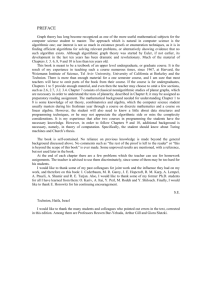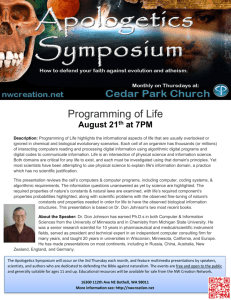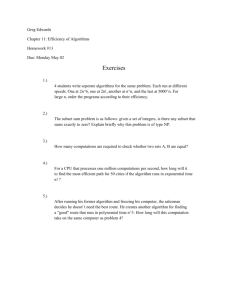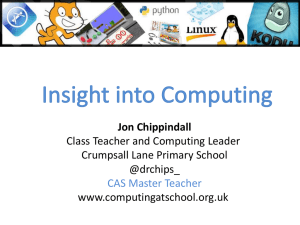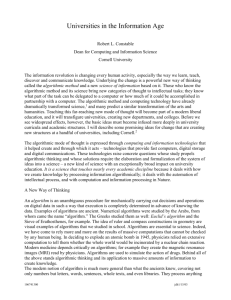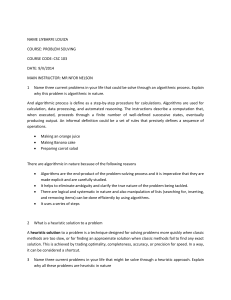Vaidyanathan-Core Topics in Parallel and
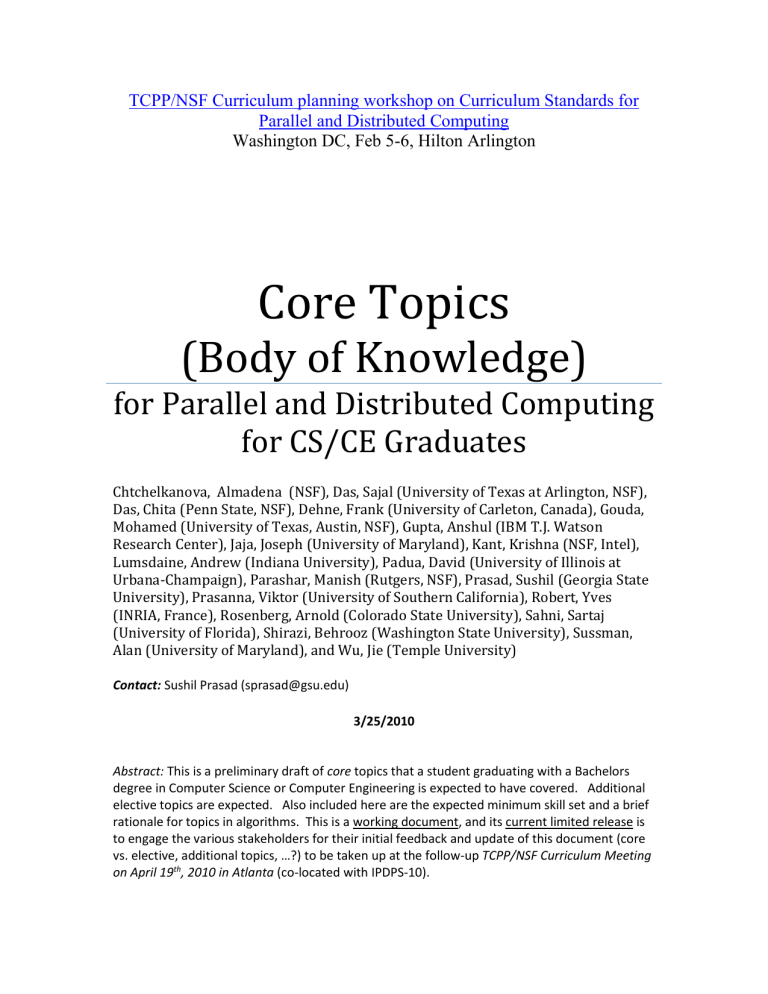
TCPP/NSF Curriculum planning workshop on Curriculum Standards for
Parallel and Distributed Computing
Washington DC, Feb 5-6, Hilton Arlington
Core Topics
(Body of Knowledge)
for Parallel and Distributed Computing for CS/CE Graduates
Chtchelkanova, Almadena (NSF), Das, Sajal (University of Texas at Arlington, NSF),
Das, Chita (Penn State, NSF), Dehne, Frank (University of Carleton, Canada), Gouda,
Mohamed (University of Texas, Austin, NSF), Gupta, Anshul (IBM T.J. Watson
Research Center), Jaja, Joseph (University of Maryland), Kant, Krishna (NSF, Intel),
Lumsdaine, Andrew (Indiana University), Padua, David (University of Illinois at
Urbana-Champaign), Parashar, Manish (Rutgers, NSF), Prasad, Sushil (Georgia State
University), Prasanna, Viktor (University of Southern California), Robert, Yves
(INRIA, France), Rosenberg, Arnold (Colorado State University), Sahni, Sartaj
(University of Florida), Shirazi, Behrooz (Washington State University), Sussman,
Alan (University of Maryland), and Wu, Jie (Temple University)
Contact: Sushil Prasad (sprasad@gsu.edu)
3/25/2010
Abstract: This is a preliminary draft of core topics that a student graduating with a Bachelors degree in Computer Science or Computer Engineering is expected to have covered. Additional elective topics are expected. Also included here are the expected minimum skill set and a brief rationale for topics in algorithms. This is a working document, and its current limited release is to engage the various stakeholders for their initial feedback and update of this document (core vs. elective, additional topics, …?) to be taken up at the follow-up TCPP/NSF Curriculum Meeting on April 19 th , 2010 in Atlanta (co-located with IPDPS-10).
Core Topics (Body of Knowledge)
Architectures o Classes
MIMD
SIMD
Distributed memory
Shared memory
Hybrid
Grid/cloud o Memory
Memory hierarchies
Caches o Interconnect
Topologies (e.g., diameter vs. bandwidth)
Routing
Switches o Power
Power sinks
Methods to control power
Algorithms o Parallel and distributed models and complexity
Cost of computation: time, space, power, etc.; Asymptotics
Cost reduction: speedup, space compression, etc.
Cost tradeoffs: time vs. space, power vs. time, etc.
Scalability in algorithms and architectures
Model-based notions:
Notions from complexity-theory : the PRAM, simulation/emulation, P-completeness, #P-completeness
Notions from scheduling : dependencies, task graphs, work,
(make)span o Algorithmic Paradigms
Divide & conquer
Recursion
Scan (parallel prefix) and reduction (map-reduce)
Series-parallel composition
Stencil-based iteration
Graph embedding as an algorithmic tool o Algorithmic Problems
Communication: broadcast, multicast, scatter/gather, gossip
Sorting & selection
Graph algorithms: search, path selection
Matrix computations: matrix product, linear systems, matrix arithmetic
Leader election
Termination detectionConsistent cuts and causality
2
Programming o Languages
Data parallel
Message passing
Threads/processes
Hybrid o Tools
Debuggers
Performance monitoring o Paradigms
Data parallel
Shared memory: threads/tasks, locks, barriers
Distributed memory : message passing, manager/worker, client/server o Program development
Task decomposition: Locality, partitioning/tiling, over-decomposition
Load balancing
Scheduling
Mapping: Static, dynamic
Synchronization: critical sections, asynchronous computation
Communication : latency hiding, aggregation of messages, false sharing o Program analysis
Dependences: task graph, span vs. work
Synchronization analysis: races, deadlocks, livelocks
3
Minimum skill set for a CS/CE graduate
An undergraduate student should be able to program parallel and distributed systems efficiently (productivity and performance) o Productivity - Languages, software engineering, programming methodologies, algorithms, parallel design patterns, tools, libraries o Performance - Execution time, power, memory, I/O, scalability, throughput
To be aware of interaction among different tools, algorithms, architectures, programming models
The knowledge should be relevant for the foreseeable future e.g., multi-core, GPUs, web-services, clusters
4
Rationale: Algorithms Topics
Parallel/Distributed Models and Complexity : It is essential to provide students with a firm background in the conceptual underpinnings of parallel and distributed computing. Technology changes in this dynamic field at a hitherto unheard of pace. Students whose education is tied too closely to current technology will be at a disadvantage when technology shifts render their knowledge obsolete. To mention just a few instances of such paradigm-changing shifts: (1) The
VLSI revolution of the late 1970s and early 1980s enabled computers with unheard-of levels of parallelism. New problems related to interprocesssor communication arose, exposing an aspect of parallel computing that could safely be ignored when levels of parallelism were very modest. (2)
As clusters of modest processors (or, workstations) joined multiprocessors-in-a-box as parallel computing platforms in the early 1990s, two sea-changes occurred: (a) computing platforms became heterogeneous for the first time, and (b) communication delays became impossible to hide via clever latency-hiding strategies. (3) As computational grids became “parallel” computing platforms around the turn of the millennium, the distinction between parallel and distributed computing became fuzzier than ever before.
Fortunately, in spite of the “leaps and bounds” evolution of parallel computing technology, there exists a core of fundamental algorithmic principles. These principles are largely independent from the details of the underlying platform architecture and provide the basis for developing applications on current and future parallel platforms. Students should be taught how to identify and synthesize fundamental ideas and generally applicable algorithmic principles out of the mass of parallel algorithm expertise and practical implementations developed over the last decades.
What, however, should be taught under the rubric “conceptual underpinnings of parallel and distributed computing?” Our choices reflect a combination of “persistent truths” and
“conceptual flexibility.” In the former camp, one strives to impart: (1) an understanding of how one reasons rigorously about the expenditure of computational resources; (2) an appreciation of fundamental computational limitations that transcend details of particular models. In the latter camp, one needs to expose the student to a variety of “situation-specific” models, with the hope of endowing the student with the ability to generate new models in response to new technology.
Algorithmic Paradigms: This section acknowledges the folk wisdom that contrasts giving a person a fish and teaching a student how to fish. Algorithmic paradigms lie in the latter camp. We have attempted to enumerate a variety of paradigms whose algorithmic utility have been demonstrated over the course of decades. In some sense, one can view these paradigms as algorithmic analogues of high-level programming languages. The paradigms in our list can be viewed as generating control structures that are readily ported onto a broad range of parallel and distributed computing platforms. Included here are: the well-known divide-and-conquer paradigm that is as useful in the world of sequential computing as in the world of parallel and distributed computing; the series-parallel paradigm that one encounters, e.g., in multi-threaded computing environments; stencil-based controllers of iterative processes; graph-embedding techniques that facilitate creating virtual computing platforms that real platforms can then emulate.
Algorithmic problems: Two genres of specific algorithmic problems play such important roles in such a variety of computational situations that we view them as essential to a education about parallel and distributed computing. Our list contains two genres of problems. (1) Several of our entries are auxiliary computations that are useful in a variety of settings. Collective communication primitives are fundamental in myriad applications to the distribution of data and the collection of results. Certain basic functions play important control functions, especially as
5
parallel computing incorporates many of the characteristics of distributed computing. The process of leader election endows processors with computationally meaningful names that are useful in initiating and coordinating activities at possibly remote sites. The essential process of termination detection is easy when parallelism is modest and processors are physically proximate, but it is a significant challenge in more general environments.
(2) Several of our entries are independent computations that are usually sub-procedures of a broad range of large-scale computations.
Sorting and selection are always near the top of everyone’s list of basic computations.
Algorithms that operate on graphs and matrices can occur in almost every application area.
Getting a handle on timing in distributed systems (or rather the lack of timing guarantees) can shape the student’s understanding of how distributed (and, to some extent, parallel) systems work.
6

